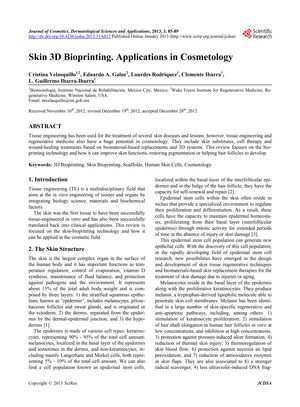TLDR 3D bioprinting could improve skin repair and treat conditions like vitiligo and alopecia by precisely placing cells.
The 2013 document reviews the use of 3D bioprinting technology in cosmetology for skin applications, emphasizing its potential in tissue engineering and regenerative medicine. It explains the skin's structure and functions, highlighting the significance of melanocytes in skin regeneration and hair follicles in wound healing. The review describes how biomaterials and synthetic polymers are used to create scaffolds for repairing skin wounds and disorders. It details the bioprinting process, which involves fabricating biological structures layer-by-layer with bio ink containing various cell types, including fibroblasts and stem cells. The document suggests that bioprinting could treat skin conditions like vitiligo and scars by precisely placing melanocytes and stem cells, and it also considers the possibility of regenerating hair follicles to address alopecia. The study acknowledges funding support from CONACYT Sectoriales and a fellowship at WFIRM.
160 citations
,
July 2008 in “Experimental dermatology” Melatonin protects the skin by scavenging free radicals and repairing DNA damage.
 49 citations
,
September 2007 in “Journal of Investigative Dermatology”
49 citations
,
September 2007 in “Journal of Investigative Dermatology” The study found that bioengineered hair follicles work when using cells from the same species but have issues when combining human and mouse cells.
 1113 citations
,
August 1999 in “The New England Journal of Medicine”
1113 citations
,
August 1999 in “The New England Journal of Medicine” Hair follicle biology advancements may lead to better hair growth disorder treatments.
 August 2023 in “European Journal of Plastic Surgery”
August 2023 in “European Journal of Plastic Surgery” 3D bioprinting is advancing in plastic and reconstructive surgery, especially for creating tissues and improving surgical planning, but faces challenges like vascularization and material development.
 43 citations
,
July 2019 in “Stem Cells International”
43 citations
,
July 2019 in “Stem Cells International” Advancements in creating skin grafts with biomaterials and stem cells are promising, but more research is needed for clinical application.
 30 citations
,
February 2022 in “Pharmaceutics”
30 citations
,
February 2022 in “Pharmaceutics” 3D bioprinting improves wound healing by precisely creating scaffolds with living cells and biomaterials, but faces challenges like resolution and speed.
 29 citations
,
December 2019 in “Stem Cells Translational Medicine”
29 citations
,
December 2019 in “Stem Cells Translational Medicine” Fully regenerating human hair follicles not yet achieved.
48 citations
,
December 2022 in “Biomolecules” 3D bioprinting shows promise for creating advanced skin for healing wounds and reducing animal testing.
41 citations
,
January 2015 in “Burns & Trauma” Tissue engineering improves burn scar reconstruction by using skin substitutes and replacing damaged tissues.







